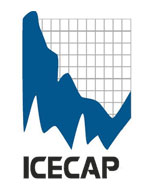By Alexandre Aguiar / MetSul Weather Center
A brutal and historical cold snap has so far caused 80 deaths in South America, according to international news agencies. Temperatures have been much below normal for over a week in vast areas of the continent. In Chile, the Aysen region was affected early last week by the worst snowstorm in 30 year. The snow accumulation reached 5 feet in Balmaceda and the Army was called to rescue people trapped by the snow.

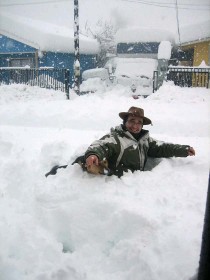
In Argentina, the snow in the region of Mendoza, famous for its winery, was described by local meteorologists as the heaviest in a decade. The temperature in the morning of July 16th was the lowest in the city of Buenos Aires since 1991: -1.5C. The cold snap caused a record demand for energy and Argentina had to import electricity from Brazil. Many industries in Argentina were shut down due to gas shortage.
It snowed in nearly all the provinces of Argentina, an extremely rare event. It snowed even in the western part of the province of Buenos Aires and Southern Santa Fe, in cities at sea level. The most famous beach of Argentina, Mar del Plata, was whitened by the snow in the morning of July 15th, a scene only seen in recent memory in 1991, 2004 and 2007.
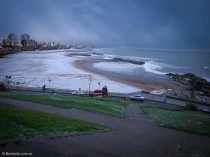

The snow was heavy even in Northern Argentina. In Santiago Del Estero, according to media reports, some areas experience snow for the first time in living memory. In the province of Tucuman, some town saw snow for the first time since 1921 (Gaceta de Tucuman newspaper).
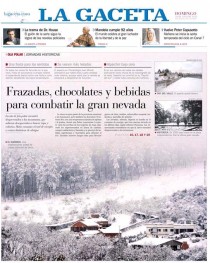
In Uruguay, there were widespread reports of sleet and even snow mixed with rain in towns in the Southern and Eastern part of the country, even in the capital Montevideo. At leas two deaths have been blamed in Uruguay on the low temperatures. Hospitals were packed with patients with respiratory illness.
In Paraguay, at least nine people died due to the cold weather in only 3 days. Cattle were very affected and one thousand animals died of hypothermia. In Bolivia, dozes of people died in consequence of the very low temperatures. In some areas of the nation the cold period was described as the worst in 15 years. It even snowed in the Chaco of Bolivia, one of warmest areas of South America, where the local population never saw snow before. Classes were suspended in Bolivia for three days to prevent more cold related deaths (El Nacional newspaper from Bolivia).

Southern Brazil was also very affected by the cold air eruption from the Southern Pole. Last week the temperature dropped to -7.8C in the city of Urupema, Santa Catarina. In Rio Grande do Sul, in the hills of the state, temperature felt to -4.9C in the city of Cambara. In the state of Paraná, the low was -6C. Only the nights were freezing, but the afternoons were very cold. In some days, temperature failed to reach 5C in many towns, the first time in a decade. Flurries observed in towns of Rio Grande do Sul, Santa Catarina and Parana and sleet was also reported in Western Santa Catarina.
The most striking scenes came from the top of Morro da Igreja, a 1800 meters elevation in the state of Santa Catarina. The area recorded snow and freezing rain. As anyone can imagine, freezing rain is extremely rare in Southern Brazil. The event was witnessed and photographed by weather observers from MetSul Marcelo Albieri and Caio Souza.
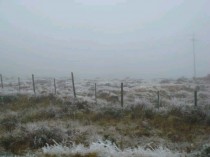

On July 14th, in the afternoon hours, temperatures in the hills of Rio Grande do Sul state in Southern Brazil were lower than in Marambio, the main polar base of Argentina in Antarctica. In Central Brazil, in the tropics, the long streak of cold days was considered extremely rare. It was so cold that thousand of animals died in this region of Brazil known for its cattle, just South of the Amazon basin.
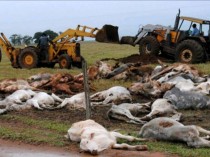
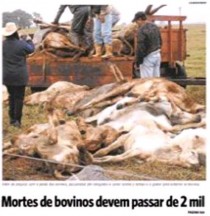
Maybe the most notable fact took place in North South America. The cold reached Amazon and temperatures felt to as low as 7C in towns in the Amazon Forest in the states of Acre and Rondonia. Temperature even felt in Roraima, where the state capital Boa Vista record 20C (normal lows are 25C) and the wind were blowing from the South. Boa Vista is located at 2 degrees North of latitude, so the influence of the Antarctic cold blast crossed the Equator line and reached towns in the Northern Hemisphere. It would be the same of a cold snap from the Arctic crossing the entire North America continent, the Caribbean and reaching North Brazil in cities at 2 degrees South of latitude as Santarem, a bizarre situation.
Image of surface temperatures departure from normal for July 17, 2010 for South America (enlarged here).
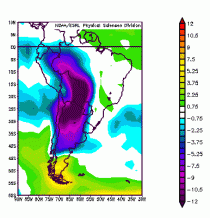
PDF here.
By James Delingpole
Have you seen the front page story in today’s Times?
It’s a cracker!
Oil giant gave 1 million pounds to fund climate sceptics, it says.
I would give you the online link but then you’d have to pay for it. And I’m not sure you’d necessarily want to do that when I tell you what the story is about. It’s about how blusteringly outraged environment correspondent Ben Webster is about the fact that evil Big Oil company Exxon is STILL funding evil Climate Deniers (though not me, yet, unfortunately) via institutions such as The Media Research Centre.
And how evil is The Media Research Centre? So totally evil that it actually had the evil temerity to refer to the latest Climategate inquiry as a “whitewash” (as if!) and to condemn “climate alarmists.”
OK. So you read this kind of non-story quite a lot on websites run by green advocacy groups like Greenpeace and the World Wildlife Fund. But that’s because, er, they’re green advocacy groups whose task it is to use the many millions of pounds they are given each year by organisations such as the EU and the UN to propagandise on behalf of green causes. We expect them to play fast and loose with the facts, to tell a deeply one-sided version of the story, to concentrate on the mote in the eyes of others while conspicuously ignoring the beam in their own.
But the Times? I thought it was supposed to be a newspaper, not a branch of Friends of the Earth or the Sierra Club. In which case, what on earth is it doing repeating a canard - “funded by Big Oil” - so stale I wouldn’t be surprised if it originally appeared below one of William Howard Russell’s dispatches from the Crimea in the 1850s.
First, if Exxon wants to put money into fostering open debate about “Climate Change”, so ruddy what? If the Climate Alarmists’ case is really so strong, it will surely be able to fend off any kind of criticism no matter how lavishly funded.
Second, is the Times seriously trying to tell us that it no longer advocates free speech? That there’s a “right” opinion and a “wrong” opinion and that people who hold the latter view - even if they are distinguished scientists - should have the oxygen of publicity removed from them with the help of hysterical front page stories bolstered with blustery quotes from the tragically inevitable Bob Ward?
Third, as Donna Laframboise is one blogger among many to have noticed, the total amount of money that goes into funding Climate realism is a drop in the ocean compared to the amount paid by governments, left-leaning NGOs and, yes, even Big Oil companies to fund Climate alarmism.
If the world is divided into two factions - one that believes climate change is a serious problem and another that thinks human influence on the climate is so minimal it’s indistinguishable from background noise - one group has pulled off a bank heist while the other has been panhandling in front of the liquor store.
Evil climate-denying Exxon, for example, has donated $100 million to Stanford university so that researchers there can find “ways to meet growing energy needs without worsening global warming”.
According to estimates by Jo Nova, US government spending on climate research and technology since 1989 has amounted to around $79 billion.
According to Dr Richard North, the amount squandered in the same period by the EU on climate funding amounts to $100 billion.
See post here.
By Andrew C. Revkin
Stephen H. Schneider, a Stanford University climate scientist who for decades built the case that global warming, while laden with complexity, justified an aggressive response, has died. Ralph Cicerone, the president of the National Academy of Sciences, of which Schneider was a longtime member, said he had confirmed the news.
Schneider, who was 65, spent decades studying the forces influencing climate and the policy implications of human-driven warming, as well as pressing the case for action to curb emissions of greenhouse gases even as he battled and subdued a rare cancer in recent years. In an e-mail message to a group of contacts, his wife, Terry Root, a biologist at Stanford, said it appeared that he died of a heart attack today as a flight he was on was landing in London.
I first interviewed Schneider in the early 1980s while trying to make sense of the percolating notion of nuclear winter, which Schneider always following the data - ended up determining would more likely be a “nuclear autumn.” It was his caustic honesty about the complex nature of global warming, and the inherent uncertainties in the science, that kept me returning to him for input from 1988 onward. He was a participant in the assessments of the Intergovernmental Panel on Climate Change from the beginning until the last days of his life. He encouraged scientists to get out and communicate directly with the public, maintaining a Web page, “Mediarology,” describing the challenges attending such a move.
In a phone chat, Cicerone at the academy described Schneider’s core traits, particularly his approach to forging policies that made sense even in the face of the persistent uncertainty about the worst-case impacts from warming:
His biggest goal in life was to see a rational approach to policy about climate change, where he tried to evaluate the odds and show people, just like in many other decisions in life, with climate they had to play the odds. He was trying to produce probabilistic ways to make evaluations that could work. In his lifetime, his approach on this became progressively more sophisticated.
He noted Schneider’s early work charting “the co-eveolution of climate and life” (the title of an early Schneider book):
It was that intellectual journey that convinced him most things are connected to climate.
Just in the last few weeks, Schneider was all over the Web, having co-authored a paper laying out the difference in expertise in the camps often cited by the media in climate coverage. Read a long Q&A Schneider conducted with Rick Piltz at Climate Science Watch for some background. Andrew Freedman at the Capital Weather Gang recently excerpted an interview Schneider gave to Stanford’s magazine.
Schneider will be missed by many for his energy, wit, ferocity, overloaded e-mail messages, guitar strumming and many other facets. I’ll be writing more shortly. Read more here.
